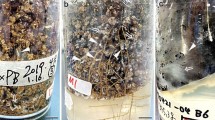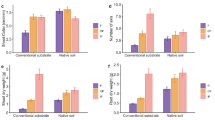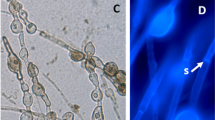Summary
Ectomycorrhizal short roots, mycelia, rhizomorphs and mats from conifer soil were examined in relation to their hydrophobic properties. In some cases connected fruit bodies were included in the study. Mycorrhizal soils gathered from the forest and/or colonized in a laboratory rhizoscope were studied, as were mycelia in pure culture. Most forest-derived species were hydrophobic. The drought-resistant Cenococcum geophilum and the more ruderal and moisture-dependent Thelephora terrestris were both strongly hydrophilic. The hydrophobic mycelium seemed solely responsible for the water repellence properties, and adjacent soil and plant debris remained unaffected and hydrophilic. In hydrophobic fungi, mat formation was induced in the rhizoscope by hyphal contact with alder litter leaves. This stimulating effect was not found when the leaves were covered by water or when fresh, green alder leaves were used. Thelephora terrestris did not form such mats in vitro and spread sparsely in air pockets as well as in the adjacent water film. The possibility is discussed that many mycorrhizal fungi in the forest may partly control their soil environment via aeration created by their hydrophobia.
Similar content being viewed by others
References
Alvarez IF, Rowney DL, Cobb FW Jr (1979) Mycorrhizae and growth of white fir seedlings in mineral soil with an without organic layers in a California forest. Can J For Res 9:311–315
Cromack K Jr, Sollins P, Graustein WC, Speidel K, Todd AW, Spycher G, Li CY, Todd RL (1979) Calcium oxalate accumulation and soil weathering in mats of the hypogeous fungus Hysterangium crassum. Soil Biol Biochem 11:463–468
Cromack K Jr, Fichter BL, Moldenke AM, Entry JA, Ingham ER (1988) Interactions between soil animals and ectomycorrhizal fungal mats. Agric Ecosyst Environ 24:161–168
Dahlberg A, Stenlid J (1990) Population structure and dynamics in Suillus bovinus as indicated by spatial distribution of fungal clones. New Phytol 115:487–493
Dahlberg A, Stenström E (1991) Dynamic changes in nursery and indigenous mycorrhizae of outplanted Pinus sylvestris seedlings in forest and clear-cut areas. Plant Soil 136:73–86
Danielson RM, Visser S (1989) Effects of forest soil acidification on ectomycorrhizal and vesicular-arbuscular mycorrhizal development. New Phytol 112:41–47
Duddridge JA, Malibari A, Read DJ (1980) Structure and function of mycorrhizal rhizomorphs with special reference to their role in water transport. Nature 287:834–836
Feil W, Kottke I, Oberwinkler F (1988) The effect of drought on mycorrhizal production and very fine root system development of Norway spruce under natural and experimental conditions. Plant Soil 108:221–231
Gadgil RL, Gadgil PD (1975) Suppression of litter decomposition by mycorrhizal roots of Pinus radiata. NZ J For Sci 5:35–41
Griffin DH (1972) Ecology of soil fungi. Chapman & Hall, London
Harley JL, Smith SE (1983) Mycorrhizal symbioses. Academic Press, London New York
Haselwandter K, Bobleter O, Read DJ (1990) Degradation of 14Clabelled lignin and dehydropolymer of coniferyl alcohol by ericoid and ectomycorrhizal fungi. Arch Microbiol 153:352–354
Meyer FH (1963) Laccaria amethystina (Bolt. ex Fr.) Berk. et Br., ein zur Mykorrhizabildung an der Buche befähigter Pilz. Ber Dtsch Bot Ges 76:90–96
Meyer FH (1987) Extreme Standorte und Ektomykorrhiza (insbesondere Cenococcum geophilum). Angew Bot 61:39–46
Mikola P, Laiho O (1962) Mycorrhizal relations in the raw humus layer of northern spruce forests. Commun Inst For Fenn 55:1–13
Parke JL, Linderman RG, Trappe JM (1983) Effects of forest litter on mycorrhiza development and growth of Douglas fir and western red cedar seedlings. Can J For Res 13:666–671
Paul EA, Clark FE (1988) Soil microbiology and biochemistry. Academic Press, San Diego
Perry DA, Molina R, Amaranthus MP (1987) Mycorrhizae, mycorrhizospheres, and reforestation: current knowledge and research needs. Can J For Res 17:929–940
Pugh GJF, Boddy L (1988) A view of disturbance of life strategies in fungi. Proc R Soc Edinb 94B:3–11
Read DJ (1987) In support of Frank's organic nitrogen theory. Angew Bot 61:25–37
Read DJ, Francis R, Finlay RD (1985) Mycorrhizal mycelia and nutrient cycling in plant communities. In: Fitter AH, Atkinson D, Read DJ, Usher MB (eds) Ecological interactions in soil. Blackwell, Oxford, pp 193–218
Stenström E (1990) Ecology of mycorrhizal Pinus sylvestris seedlings — aspects of colonization and growth. PhD dissertation, Swedish University of Agricultural Sciences, Uppsala
Stenström E (1991) The effects of flooding on the formation of ectomycorrhizae in Pinus sylvestris seedlings. Plant Soil 131:247–250
Tan KH, Sihanonth P, Todd RI (1978) Formation of humic acid like compounds by the ectomycorrhizal fungus, Pisolithus tinctorius. Soil Sci Soc Am J 42:906–908
Unestam T, Stenström E (1989) A method for observing and manipulating roots and root-associated fungi on plants growing in nonsterile substrates. Scand J For Res 4:51–58
Author information
Authors and Affiliations
Rights and permissions
About this article
Cite this article
Unestam, T. Water repellency, mat formation, and leaf-stimulated growth of some ectomycorrhizal fungi. Mycorrhiza 1, 13–20 (1991). https://doi.org/10.1007/BF00205897
Issue Date:
DOI: https://doi.org/10.1007/BF00205897




